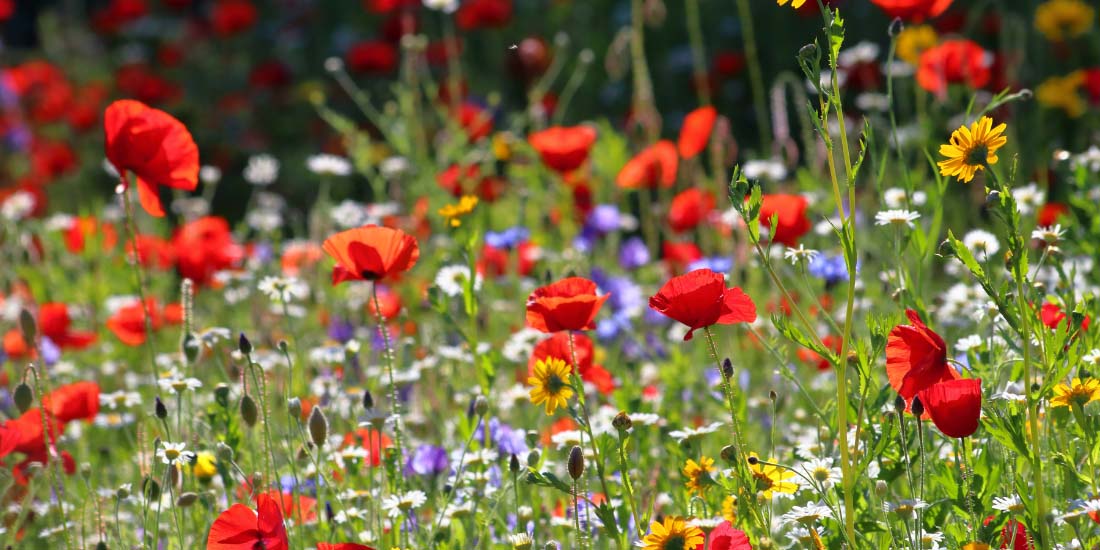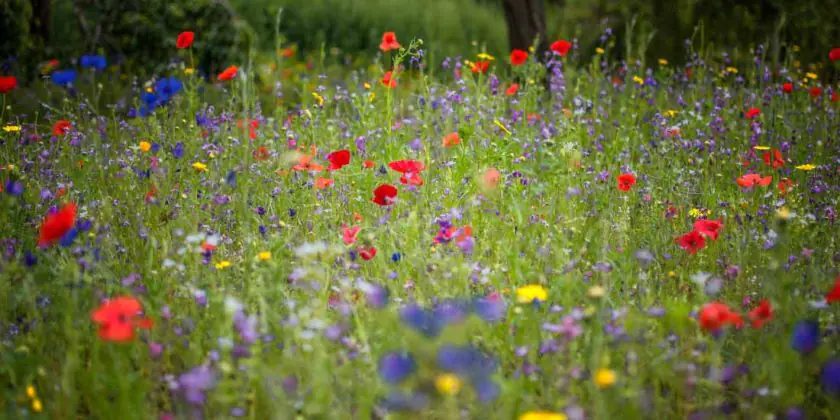When to plant wildflower seeds

Knowing when to plant wildflower seeds not only ensures your seeds have the right conditions to germinate but also means you will know when to expect them to bloom. Your wildflowers will provide beautiful blooms if you plant your seeds at the right time of year, prepare the soil to create the perfect seedbed and pick the right seed mix for your garden!
Deciding when to plant wildflower seeds
Wildflowers differ from grass in terms of not needing a certain temperature to germinate. By knowing when to plant wildflower seeds, you will be aware that the ideal planting season for wildflowers is typically from March to October, and annual wildflowers bloom 60-80 days after planting.
Also, be aware that wildflower mixes that do contain meadow grasses require minimum temperatures of 8-10 degrees to germinate, so you will need to check your local weather forecast before starting.
Ready to sow wildflower seeds
You can also plant wildflower seeds later in the season (in autumn) for an early showing the next year. This is because a winter freeze helps break their dormancy (known as stratification) and kickstarts germination for faster growth once the warmer weather returns. However, since our seeds are stored in cold conditions all year round, they will be ready to plant and begin to grow at any time of the year! But just be aware that if you sow your seeds late in the season, they will not show until the following spring.
When is the best time for planting wildflowers from seed
Planting wildflowers in spring
- Planting wildflower seeds in early spring (March to April) shows blooms from annuals in your wildflower mix in summer. However, perennials in the seed mix will not appear in the first year and will show early the following spring.
Planting wildflower seeds in autumn
- For the best results and fastest turnaround, we recommend planting your wildflower seeds in early autumn (September to October). This ensures your garden will be filled with beautiful wildflowers come spring. And since they have experienced winter’s germination-enhancing stratification, they will begin pushing out of the soil shortly after the warmth of spring arrives!
Choosing the best wildflower seed mix to plant
We have a wide range of high-quality wildflower seed mixes suited to various gardens, soil types and individual tastes. So, whether you want vibrant pops of colour as soon as possible, a long-lasting wildflower meadow for bees and pollinators, or just some native wildflowers to grow in areas of your garden that are usually barren – we have wildflowers for every situation!
Annual wildflower seed mixes

If you would like your annual wildflowers to return the following year, let them go to seedhead at the end of the season. Then, collect the seed heads and manually assist their self-seeding by firming them into the soil. This will encourage the flowers to sprout again the following spring.
Perennial wildflower seeds

We also have wildflower mixes that contain combinations of both annuals and perennials for various flower types that bloom throughout the year. We have mixes that include annuals and perennials combined with meadow grasses, which provide an even more beneficial habitat for bees, other pollinators and local wildlife.
You can read more about annual and perennial wildflowers in our helpful annuals vs perennials wildflower guide, which looks at the traits, advantages and beauty of both types of wildflowers.
Our wildflower seed mixtures below include some information on what benefits they can offer your garden:
Wildflower Mixes for Normal Soil Types in Non-Shaded Areas:
- Annuals Mix (does not include grass) – packed with the nation’s favourite cornfield annuals for decorative and vibrant pops of colour and sweet smells.
- Meadow Magic (does not include grass) – a mix of UK native annuals and perennials that provides a flora-full meadow ideal for adding to any garden.
- Bees and Pollinators (includes grass) – this mix is RHS Plants for Pollinators approved and is packed with expertly picked UK native annuals and perennials that greatly benefit native bees and pollinators.
- Flowering Meadow (includes grass) - contains a mixture of RHS Plants for Pollinators approved UK native annuals and long-lasting perennials that are sure to add a dynamic range of colours and shapes to your garden.
Wildflowers for Shaded Areas:
- Shaded Area Wildflowers (includes grass) - contains UK native annual and perennial wildflowers that grow naturally in forested areas. These flower species are shade-tolerant and ideal for areas of your garden covered by shadow for most of the day and for areas with little growth. This mix also includes meadow grasses that help provide a canopy habitat for pollinators and local wildlife.
Wildflower Mixes for Problematic Soils:
- Sandy Soil Wildflower (includes grass) – this mix features an expertly chosen blend of UK native annual and perennial wildflowers to thrive in sandy soils and contains arable grasses. It’s also an excellent food source for bees and other pollinators while featuring RHS Plants for Pollinators-approved flowers.
- Heavy Clay Soil Wildflower (includes grass) – packed with UK native annual and perennial wildflowers that thrive in clay soils. This mix offers a year-on-year range of species variety and colour and contains complementing arable grasses.
How to plant wildflower seeds
Once you have picked your preferred time to plant your wildflower seed, the next step is to prepare the area for growing. This involves removing existing grass, weeds, flora, and rocks or branches from the area. Clearing this all away will give your new seeds the best conditions and stop anything unnecessarily hindering their growth.
With the area cleared, you can begin the final preparations and then get planting:
- If your garden has fertile soil in the area where the wildflowers will be planted, then it’s best to remove the top 5-10cm to reduce soil fertility.
- After this, you should allow the area to cultivate for a few weeks.
- Then, remove any weeds that may show in the area during this time.
- There is no need to add compost or topsoil before planting since wildflowers prefer low-nutrient conditions.
- After this, you want to level the seedbed.
- Do this by raking the area while removing any other stones and breaking down any clumpy soil, so that the soil is fine and even.
- Then, scatter the seed at a rate of 5g per m2.
- Followed by raking the seed in amongst the soil.
- Water the seeds well.
- Keep the soil moist for the first six weeks after planting if you’re doing this in warm conditions.
Happy wildflower seed sowing!
After reading this blog, you now know when to plant wildflower seeds, how to choose the best wildflowers and how to prepare your soil for planting. We understand, however, that everyone’s gardens are different, so if you have any questions, please let us know, and we will be happy to help!
We also have further reading for looking after a wildflower meadow to help you and your local wildlife get the most from the growth of your wildflowers: